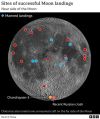- Joined
- Dec 4, 2010
- Messages
- 1,150
- Reaction score
- 1,637
India is hoping to make history on Wednesday by becoming the first nation to land near the Moon's south pole.
One of the mission's major goals is to hunt for water-based ice, which scientists say could support human habitation on the Moon in future.
If Chandrayaan-3 is successful, India will be only the fourth country to have achieved a soft landing on the Moon.
India's attempt comes just days after Russia's Luna-25 crashed while trying to touch down in the same region.
The south pole of the Moon holds special promise in the search for water ice. The surface area that remains in permanent shadow there is huge, and scientists say it means there is a possibility of water in these areas.
The US, the former Soviet Union and China have all achieved a soft landing near the Moon's equator - but none have led successful missions to its south pole.
India's attempt to land its Chandrayaan-2 mission near the south pole in 2019 was unsuccessful - it crashed into the lunar surface.
So all eyes are now on Chandrayaan-3 - its third mission to the little-explored Moon.
The spacecraft with an orbiter, lander and a rover lifted off on 14 July from the Sriharikota space centre in south India.
The lander - called Vikram after Indian Space Research Organisation (Isro) founder Vikram Sarabhai - carries within its belly the 26kg rover named Pragyaan, the Sanskrit word for wisdom.
One of the mission's major goals is to hunt for water-based ice, which scientists say could support human habitation on the Moon in future.
If Chandrayaan-3 is successful, India will be only the fourth country to have achieved a soft landing on the Moon.
India's attempt comes just days after Russia's Luna-25 crashed while trying to touch down in the same region.
The south pole of the Moon holds special promise in the search for water ice. The surface area that remains in permanent shadow there is huge, and scientists say it means there is a possibility of water in these areas.
The US, the former Soviet Union and China have all achieved a soft landing near the Moon's equator - but none have led successful missions to its south pole.
India's attempt to land its Chandrayaan-2 mission near the south pole in 2019 was unsuccessful - it crashed into the lunar surface.
So all eyes are now on Chandrayaan-3 - its third mission to the little-explored Moon.
The spacecraft with an orbiter, lander and a rover lifted off on 14 July from the Sriharikota space centre in south India.
The lander - called Vikram after Indian Space Research Organisation (Isro) founder Vikram Sarabhai - carries within its belly the 26kg rover named Pragyaan, the Sanskrit word for wisdom.
What time will the Chandrayaan-3 lander arrive at the Moon?
- Chandrayaan-3's lander is scheduled to start its descent at 17:45 India time on Wednesday (13:15 BST)
- The lander will attempt touchdown at 18:04 local time (13:34 BST)
- Scientists say the few minutes prior to landing will be the most crucial as the lander attempts to make touchdown on an area that is "very uneven, full of craters and boulders", with some predicting it will be "15 minutes of terror"
- If the landing is successful, Isro is expected to start releasing images from the lunar surface at a later stage.

